Author:
Tero Ranta and Rodd Novak, Peregrine Semiconductor
Date
01/01/2012
Thinner form factors, mobile TV and the requirement for power efficiency are placing extreme demands on the antenna, requiring a new approach to keep calls on track and antennas inside the handset. Footprints are shrinking inside wireless and mobile devices, making a significant impact on antenna performance. Portable system designers need to contend with very small antennas that must support voice calls from 824 to 2170 MHz (or more), different modulation schemes, high data rates, and mobile TV channels ranging from 470 to 862 MHz—all in a thinner form factor. Many of the latest portable wireless designs constrain the antenna to a historically small area, and, in many cases, the antennas are literally wrapped around peripheral functions in the handset. This approach often makes the antenna more susceptible to detuning by environmental effects and lowers the antenna's efficiency. As an added challenge for mobile TV, when an antenna is constrained to a very small form factor such as this, it cannot receive all of the required TV frequencies at high efficiency without some sort of reliable tuning technology. To be viable in a portable device, antenna tuning technologies need to be low-loss, highly linear, able to handle very high RF signal levels of 30Vpk or +40dBm, and consume low power. Fortunately, electronically-tunable devices that are robust enough and use proven high-volume technologies are already available, and they will enable mobile handset designers to embed mobile TV antennas and take voice and data performance to the next level.
As mobile handset antennas are wrapped and re-pathed, they lose efficiency. Fortunately, some of this lost performance can be recovered with antenna tuning, in which the system uses dynamic impedance tuning techniques to optimize the antenna performance for both the frequency of operation and environmental conditions. This same type of antenna tuning can be used to track mobile TV channels with an embedded antenna. For mobile TV applications, the achievable bandwidth and input match is directly related to the physical size of the antenna and the mobile phone. A "tunable" internal antenna would cover a narrow section of the 470 to 862 MHz bandwidth that is quickly retuned as the desired receive channel changes, ensuring that most of the signal power captured by the antenna actually ends up in the receiver. The UHF band for DVB-H mobile TV is divided into 48 channels that are 8MHz apart. In order to provide high-quality mobile reception, the antenna will need 16 or 32 tuning states. Figure 1 compares the input impedance of an embedded mobile TV antenna with fixed matching and one with a tunable matching circuit. Note the VSWR of the antenna without tuning is 6:1, but with tuning circuitry, matching is very good at better than 2:1 across the entire band. So, to achieve satisfactory performance, the only real options for handset designers incorporating mobile TV is to use an external whip antenna or a narrowband tunable antenna.
Mobile TV is a receive-only system, so an open-loop antenna tuning method (Figure 2) is required. Here, the center frequency of the antenna is tuned based on a look-up table for the tunable component as a function of the desired receive frequency. Because an open-loop system does not measure the operation of the antenna in real time, it cannot take into account environmental conditions. In a mobile device, the environment is constantly changing as a cellular subscriber walks, drives, or moves his or her fingers (the so-called 'head and hand' effect). To address the needs of cellular frequencies that are detuned due to low efficiency or environmental conditions, adaptive closed-loop antenna tuning can be used (Figure 2). Here, a mismatch sensor tracks the antenna's operation by measuring power that is reflected back to the antenna (VSWR) and makes necessary adjustments to the impedance tuning circuitry. In this way, a closed-loop antenna tuner tracks the optimal frequency and matches for the antenna in all use cases. The tuning algorithm forces the tunable elements to constantly track and adjust to the optimal setting as environmental conditions change.
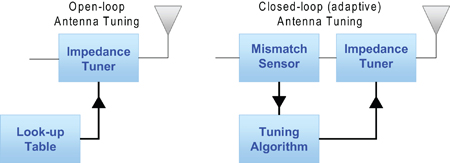
It is clear why tuning technologies are necessary for embedded mobile TV antennas, but how necessary is antenna tuning for cellular frequencies? Absorption loss in the body, mismatch loss in the antenna, ripples in the RF filter passband, and reduction in output power due to low efficiency all combine to severely reduce the power radiated out of the handset. These effects are directly visible to the consumer as a decrease in battery life, degradation of call quality, and an increase in dropped calls. To guard against these problems, many network operators are adopting radiated power requirements for handset antennas. For example, Total Radiated Power (TRP) and Total Isotropic Sensitivity (TIS) specifications are now being tested by simulating actual use cases with head and hand configurations rather than testing the phone in free space or performing a conducted measurement in a controlled impedance environment. In order to meet these new stringent power specifications, adaptive antenna tuning may be the only option for mobile handset designers. An antenna tuner forces the antenna to appear 50? despite environmental effects, so the rest of the system operates optimally, which significantly improves the TRP. Even though an antenna tuner causes additional insertion loss when the antenna is at 50? (VSWR 1:1), adaptive antenna tuning will significantly improve the overall insertion loss from the tuner input to antenna input compared to uncorrected situation (Figure 3), and provide performance improvements in the power amplifier (PA) and RF filters as well.
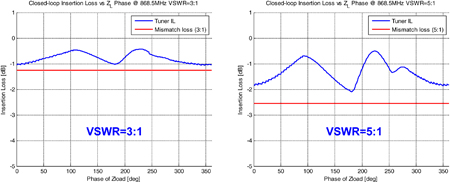
While the case for antenna tuning technology has been strong for some time, the challenge has been the absence of a high-performance, electronically-tunable reactive component that is low loss and has a wide enough tuning ratio to handle both cellular and mobile TV frequencies. Since it is connected to the antenna, any tuning circuit used needs to be extremely linear so as not to generate harmonics or intermodulation distortion. The tunable element, such as variable capacitor, needs to have a tuning ratio of at least 3:1 or better. In addition, the whole circuit must have power consumption of less than 1mA. Finally, the tuning circuitry must be small, rugged, and reliable. It needs low insertion loss and a high quality factor (Q). The most challenging component requirements have been power handling and linearity, especially in the presence of GSM signals. Although GSM antennas transmit at power levels up to +33dBm, under mismatch conditions the tunable component must be able to handle RF signal levels up to 30Vpk or +40dBm. Numerous materials and technologies have been proposed over the years to implement tunable antennas and filters, but these techniques have not been able to overcome technological and marketability hurdles, so they are not suited for high-volume production.
In response, designers at Peregrine Semiconductor have leveraged proven UltraCMOS™ process and HaRP™ design innovations[i] to develop DuNE™ technology, a patent-pending design methodology that is being used to develop Digitally Tunable Capacitors (DTCs). This solid-state DTC can be designed to meet the challenges of both cellular handset and mobile TV antenna tuning. It is a fully integrated way to implement a variable capacitor with digital control whose basic design can be adapted for open-loop (mobile TV) and closed loop (cellular) antenna tuning applications. Because they are manufactured on the UltraCMOS process, the DuNE DTC products can integrate the digital functions (CMOS control, digital processing, serial peripheral bus, tuning algorithm), analog functions (mismatch sensors, charge pumps, biasing circuitry), as well as RF passive (high Q capacitors), and RF active (switches, ESD protection) circuitry in addition to the DTC core. And, thanks to a fully insulating sapphire substrate, UltraCMOS field effect transistors (FETs) can be stacked to handle high RF power levels, unlike bulk CMOS and silicon on insulator (SOI) technologies. As a result, a DuNE DTC's power handling can be scaled from +20dBm to more than +40dBm, easily withstanding the high RF power levels encountered in GSM and WCDMA operation without degrading the Q or tuning ratio.
For cellular applications, DuNE DTCs (Figure 4) are being designed with capacitance values from 0.5pF to 10pF, with typical tuning ratios ranging from 2:1 to 10:1 with 5 bits or 32 states of resolution (Figure 5).
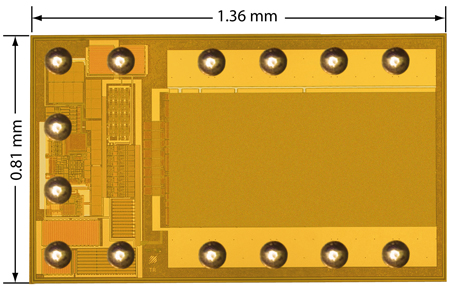
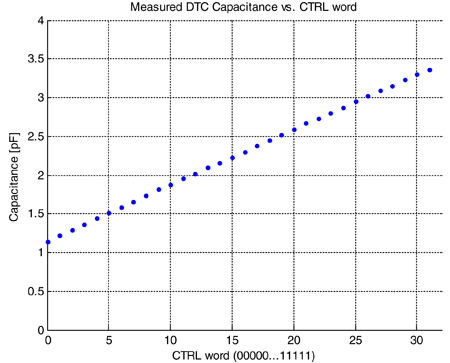
Typical Q values range from 40 to 80 at 1-2GHz (Figure 6). In addition to >+38dBm of power handling in 50? (Figure 7) and switching speed of better than 5μs, this new technology meets other necessary specifications for a cellular antenna tuning circuit. For instance, the power consumption is about 100μA.
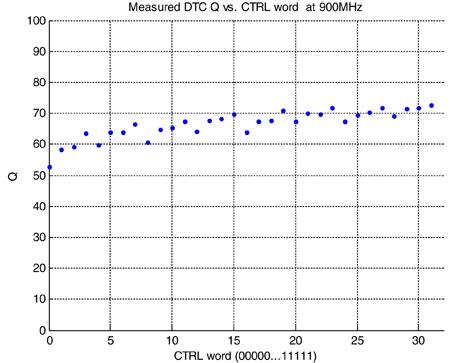
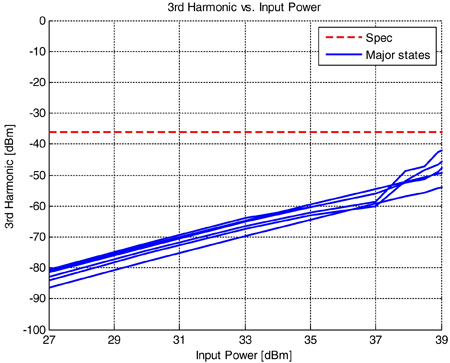
We expect the footprint for mobile handset circuitry will continue to shrink and performance demands will continue to grow. Fortunately, DuNE technology addresses all of the required performance points for embedding tunable antennas in mobile handsets. Depending on the application, these self-contained UltraCMOS RFICs communicate directly with the cellular transceiver and baseband or the mobile TV receiver chipset. They integrate a digital communication interface and all the other required functionality monolithically on the die, which minimizes lines and connections between devices. This new technology is based on proven building blocks and process technologies that are already shipping millions of units per week to the handset industry. DuNE DTCs for cellular applications are sampling now, and they are expected to be in volume production in late 2010. Ultimately, DuNE technology allows for monolithic integration of the complete adaptive antenna tuner system, which promises to help handset designers meet and beat the challenging antenna performance and size requirements of the future. www.peregrine-semi.com